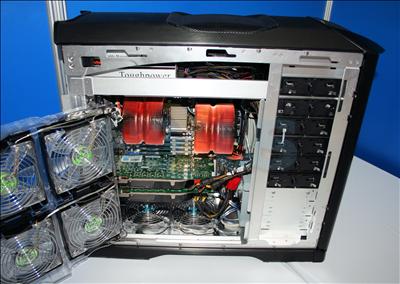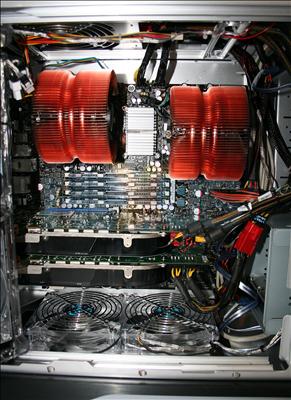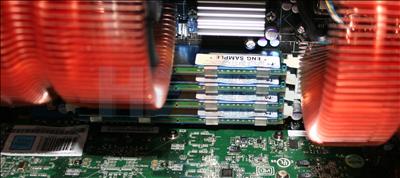Skulltrail unlesahed
Intel Skulltrail preview
Intel was only too pleased to demonstrate its upcoming ultra-high-end gaming platform behind not-so-closed doors at IDF 2007.Skulltrail is the successor to the V8 eight-core, multi-GPU gaming platform that was debuted to a lukewarm reaction a few months ago. The original Skulltrail was a knee jerk reaction to the much-maligned AMD Quad FX system, we reckon.
As with the original V8 platform, the 'new and improved' Skulltrail uses server-oriented underpinnings to form the base of what Intel hopes will be the ultimate gaming machine.
Based around the Stoakley platform that we benchmarked a couple of days ago, we learned that Skulltrail amalgamates a couple of Penryn-based quad-core processors that aren't simply regular LGA771 Xeon Harpertowns shoehorned in to a different platform. Rather, they've been 'optimised' for the gaming nature of the system. Just what these optimisations are isn't clear just yet, although Intel alluded to improvement in some of the CPUs' prefetch buffers. The CPUs sit on a cut-down Seaburg chipset that packs in a total of 44 PCIe lanes, PCIe 2.0 support, and DDR2 FB-DIMMs operating at 800MHz.
What's interesting is that Skulltrail mkII's Seaburg motherboard supports NVIDIA's SLI technology through the use of a couple of MCP chips, and the abundant PCIe lanes allow for possible quad-SLI action, albeit with suboptimal bandwidth to and from each graphics card.
Shipping systems will have highly tweakable BIOSes, allowing enthusiasts to push their systems to the very limit, an Intel representative commented.
Asked why Intel was bothering with an expensive platform whose appeal is limited to a very niche market, the response, 'because we can', was typical of a company that has, evidently, too much money to squander on pet projects.
Skulltrail mkII should be shipping in Q1 2008, we were told, and we shudder to think of just how much a high-end system will cost.
Read on to see just how fast it ran during a brief Intel-controlled benchmarking session.












